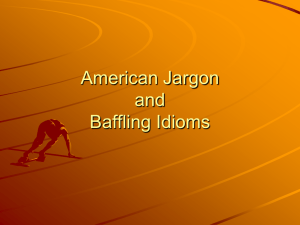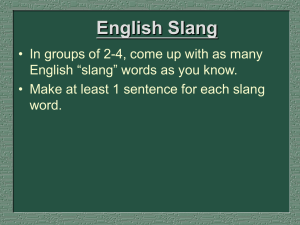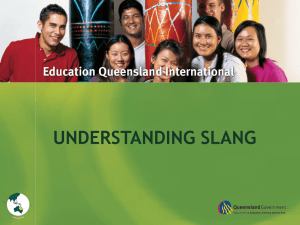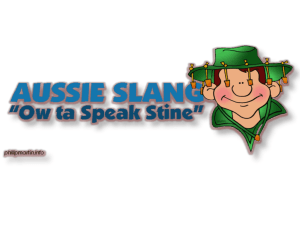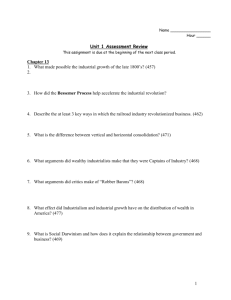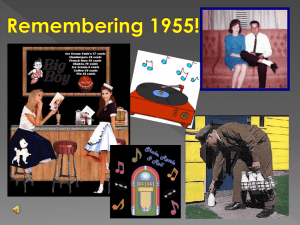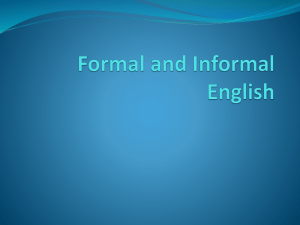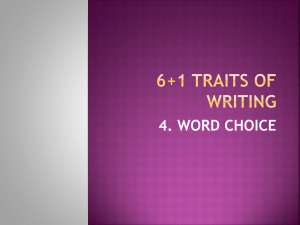Short-answer questions. - Belmont High School
advertisement
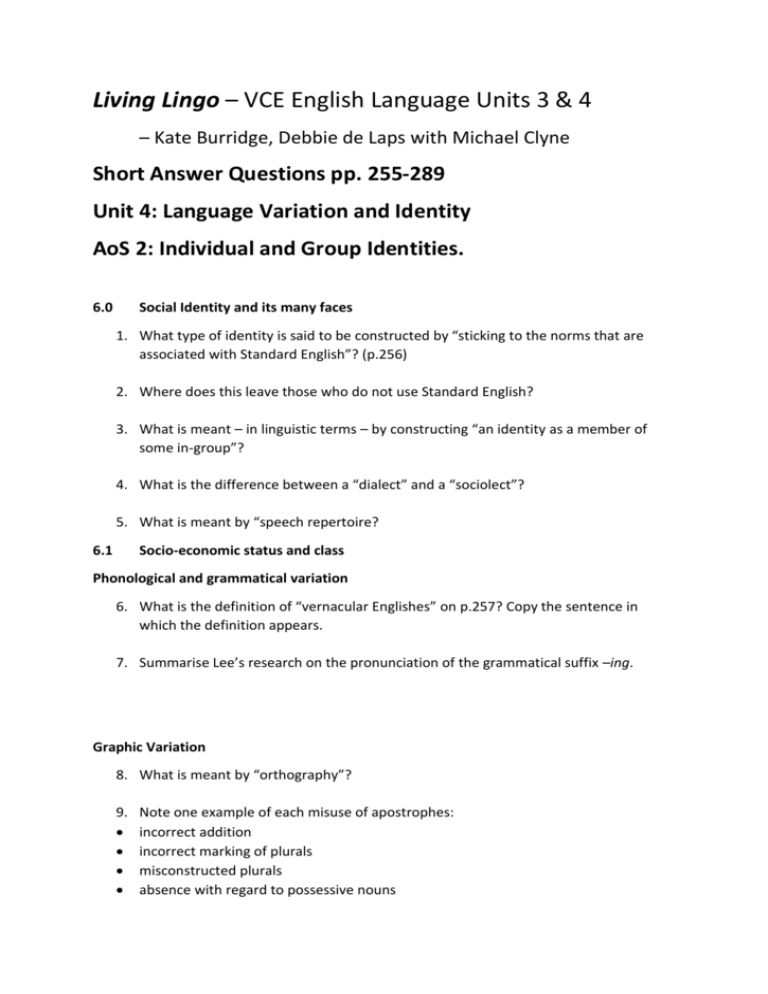
Living Lingo – VCE English Language Units 3 & 4 – Kate Burridge, Debbie de Laps with Michael Clyne Short Answer Questions pp. 255-289 Unit 4: Language Variation and Identity AoS 2: Individual and Group Identities. 6.0 Social Identity and its many faces 1. What type of identity is said to be constructed by “sticking to the norms that are associated with Standard English”? (p.256) 2. Where does this leave those who do not use Standard English? 3. What is meant – in linguistic terms – by constructing “an identity as a member of some in-group”? 4. What is the difference between a “dialect” and a “sociolect”? 5. What is meant by “speech repertoire? 6.1 Socio-economic status and class Phonological and grammatical variation 6. What is the definition of “vernacular Englishes” on p.257? Copy the sentence in which the definition appears. 7. Summarise Lee’s research on the pronunciation of the grammatical suffix –ing. Graphic Variation 8. What is meant by “orthography”? 9. Note one example of each misuse of apostrophes: incorrect addition incorrect marking of plurals misconstructed plurals absence with regard to possessive nouns Modes of Address 10. What is an ‘honorific’? 11. What is meant by saying that ‘mate’ can have ‘a mitigating intention’? 12. What can terms of address, greetings and closure indicate? Rapport talk and the significance of silence (p.260) 13. What is meant by ‘verbal cuddling’? In general terms, what is said about ‘verbal cuddling’ and the ‘tolerance of silence’? 14. What is meant by ‘phatic communication’? 6.2 Gender pp. 261-267 Lexical and Semantic Variation 15. What two quite contradictory things re language have women as a group been blamed for? 16. What is “leximania”? Gender differences in conversational management 17. What is the widespread belief as to who talks more – men or women? What does the research show? Name two linguists who have researched/commented on this. Cite 2 instances of data. 18. What role has context been shown to play with regard to the extent of contributions by males and females in discussions/conversations? 19. List 5 specific ways in which women’s role in communication typically differs from that of men around the English-speaking world. (bottom p. 263- top p. 264) 20. According to linguist Pamela Fishman what do women do more of? Gender differences in swearing (p.264) 21. In a couple of lines summarise the traditional differences between men and women with regard to swearing. 22. Have these traditional differences changed much? Phonological and grammatical variation (p.265) 23. How do men and women of the same social class, age and education compare in their use of Standard English and formal styles? (p.266) 24. Give 3 factors that can be seen as “macho identity markers”. 25. Who are the most frequent users of High Rise Terminal (HRT)? Give two possible reasons for this – one pertaining to males; one to females. 26. What have linguists identified as the relationship between the reaction to broad accents and the gender of such speakers? 27. Give one way in which Julia Gillard’s pronunciation is not broad. 6.3 Generation (p.267) 28. Complete the sentence: Youthspeak or Teenspeak is a significant …. (p.268) Lexical Variation 29. Can you think of an example of “Teenspeak” slang that has had “a high turnover rate without any long-term impression on the language? 30. Look at the words in italics in the bottom paragraph of p.268 and the first paragraph of p. 269. List them in the following table: Solidly in my current vocabulary Declining as part of my vocabulary Never part of my vocabulary 31. Why is “awesome” said to be likely to become less of a market of youth groups/teenspeak? 32. What is an “intensifier”? What part of speech (word class) are most intensifiers? 33. List 2 intensifiers said to be part of teenspeak in 2000. Are they still used? What are your favourite intensifiers? Phonological variation 34. Comment on tapping/flapping re American English and Australian English. Try saying the following with a flap: attitude, beauty, beautiful, theoretical, automatic. 35. Comment of [t] glottalisation. Try saying the following with a glottal stop: paint that, cotton, Martin, smitten. 36. Note the linguist who identified the above trends. 37. What is meant by the “natural linguistic change – function words typically reduce over time”? (bottom p. 271) Grammatical Variation 38. With regard to non-standard forms, what were working class boys in Sydney between the ages of 13 – 16 found to do? Give 3 examples of their use of such forms. 39. Re the above, what did girls tend to do? 40. Note the linguist who identified these trends. 41. What is post-sentential negation? 42. Why are “funner” and “funnest” non-standard? 43. What do Burridge et al say about teenagers’ use of “so”? Discourse Markers 44. Why is it said that teenagers use discourse markers so extensively? 45. Older people will describe you as what sort of a generation? 46. Give 3 distinct uses of “like”. 47. Compare the quotative use of “like” with that of “go”. 48. What advice do Burridge et al give re the use of discourse markers? 7 Language in Use (p.275) 49. In addition to getting the job done, what additional functions do jargons fill? 50. List 8 groups of people who use jargon. These can but don’t have to be from Living Lingo. 51. What are 3 situational variables that result in jargons not being fixed? (p.276) 52. List 4 ways in which jargons can be categorised. 53. Make sure you’ve read “The poetry of sportstalk” (p.278) 54. Which is the better use of language: “hitting a naught child” or “punitive external control” ? (p.279) 55. Linguistically analyse: “punitive external control” 56. What is the meaning of the quote from the British Journal of Sociology? (p.279) 7.2 Slang 57. List 4 examples of “hospital” slang. 58. List 4 terms that refer to illicit drug types or drug activity. 59. Are “slang” and “colloquialisms” synonymous terms? (No explicit answer to this in Living Lingo) 60. Is “slang” synonymous with “bad language”? Slang versus Jargon 61. What are 3 important forces behind slang? (p.281) Think of an example of each. 62. What are 2 differences between slang and jargon? (p.282) 63. To what extent is Aussie strine a modern-day fiction? (p.284) 64. What is the meaning of “The curious thing about stereotyping is its tendency towards fossilisation.”? (p.284) 8.0 Linguistic Prejudice and Stereotyping 65. What is linguistic prejudice? (p.283) 66. What will speakers usually infer from other people’s speech? 67. Define overt and covert prestige. 68. Summarise the interesting findings of research by sociolinguist John Edwards in 1979. 69. Summarise the findings re the lectures by the psychologist. 8.1 So why doesn’t everyone speak properly then 70. Why don’t… people speak the way they think they should? 71. What are the 2 main functions of language? 72. What is meant by Jeff Siegel’s phrase “the double dose of foreignness”? (p.285) 73. In what ways do “so called low or powerless speech styles” win out? 9.0 Online identities and politeness revisited 74. Summarise Amanda Young’s findings regarding the different approach to “politeness” many people have when their contact is face-to-face compared with their internet persona. (p.288) 75. What does Catherine Deveny compare “twitter” with? 76. What is meant by “phatic lubricant” and why is twitter largely without it? 77. In what ways does the analogy between “twitter and “passing notes in class not apply? (p.289) 78. The 2nd last paragraph on p. 289 poses many questions to the reader – you – to ask yourself. Reflect on these. What are your answers (or at least some of them)? 79. Note: the communications revolution is just beginning.
